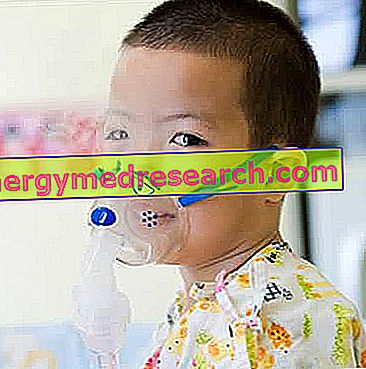Generality
Oxygen therapy consists of the administration of an additional quantity of oxygen, for therapeutic purposes.

The situations that require the use of oxygen therapy are varied: among the chronic conditions, there are COPD, chronic bronchitis, asthma, cystic fibrosis and pulmonary emphysema; among acute conditions, on the other hand, severe anaphylactic crises, severe hemorrhages, episodes of shock, the state of hypoxaemia and hypothermia deserve a mention.
Currently, the most common sources of oxygen, both in hospitals and at home, are: oxygen tanks in gaseous form, oxygen containers in liquid form and oxygen concentrators.
The possible ways of administering oxygen vary from facial masks and nasal tubes, to tracheostomy tubes, to the hyperbaric chamber, to oxygen curtains etc.
Oxygen therapy is a fairly effective and safe practice, which only gives rise to complications in rare circumstances.
What is oxygen therapy?
Oxygen therapy is the administration of a gaseous mixture with a high oxygen content, carried out for therapeutic purposes, by means of a special dispensing instrument.
In other words, therefore, oxygen therapy is a medical treatment, in the same way as for example a drug therapy, while oxygen is a medicine, just like for example aspirin.
ORIGIN OF OXYGEN THERAPY
Oxygen therapy has begun to be a widespread medical treatment since 1917.
Today, according to the World Health Organization, it is one of the safest and most effective forms of therapy available.
uses
In general, physicians oxygenate patients presenting reduced levels of oxygen in the blood, a condition that prevents the body from functioning properly and puts its survival in serious danger.
Acute or chronic conditions can lead to a decrease in blood oxygen levels in an individual. Oxygen therapy is ideal for both circumstances.
CHRONIC CONDITIONS REQUIRING OXYGEN THERAPY
The most common chronic conditions, which require oxygen therapy, are:
- COPD, also known as chronic obstructive pulmonary disease;
- Chronic bronchitis;
- Asthma;
- Bronchiectasia;
- Pulmonary emphysema;
- Pulmonary fibrosis and interstitial disease;
- States of cardio-respiratory failure at an advanced stage;
- Advanced cancers;
- Advanced neurodegenerative diseases;
- Cystic fibrosis.
As a rule, the use of oxygen therapy, in the presence of a chronic condition, is long-term .
ACUTE CONDITIONS THAT REQUIRE OXYGEN THERAPY
The acute conditions that make the use of oxygen therapy indispensable are medical emergencies, which require immediate life-saving therapy.
The acute conditions in question include:
- Anaphylaxis;
- Severe blood loss (severe bleeding);
- The episodes of shock;
- The most serious traumas;
- Hypothermia;
- The causes of hypoxemia;
- The episodes of carbon monoxide poisoning;
- Gas embolism.
In general, the use of oxygen therapy, on the occasion of an acute condition, is short term .
WHERE DOES OXYGEN THERAPY MEAN?
Oxygen therapy is a medical practice that, depending on the case, can be hospital or home based .
It is hospital, when the condition that makes it necessary is acute, requires continuous medical monitoring of the patient and requires other life-saving treatments that can only be implemented in an ad hoc center.
At home, on the other hand, when the condition for which it is carried out tends to be chronic, it presents a slow evolution, it is under control - even if clinically it is considered very serious - and, finally, it does not prevent the patient from providing, in case of need, to the self-management of the oxygen supply instrument.
Techniques and instrumentation
Currently, the most common oxygen supply sources for oxygen therapy are 3:
- Oxygen tanks in gaseous form . They are compressed oxygen cylinders. They are made of metal and can have different sizes. Clearly, the larger cylinders contain more oxygen than the smaller ones, so they last longer over time.
Smaller oxygen cylinders have such dimensions and weight that patients, if the conditions for home-based oxygen therapy are met, are able to carry them with them, inside a backpack or using a trolley.
- Oxygen containers in liquid form . The oxygen present in these containers is a refrigerated liquid, which becomes a gas when it is released, through a special boiling mechanism.
Refrigerated liquid oxygen containers are generally large and are used mainly in hospitals.
There is the possibility of decanting the refrigerated liquid oxygen from the large containers mentioned above to smaller containers; the latter are ideal for home-based oxygen therapy.
Refrigerated liquid oxygen costs more than compressed gaseous oxygen in cylinders; moreover, it evaporates more easily, so it is difficult to preserve for a long time.
- The so-called oxygen concentrators . They are particular electrical instruments, which, once activated, take the air present in the environment and, of the various gases that this air contains, only preserve oxygen. From this, concentrated oxygen is derived.
Oxygen concentrators are small instruments, convenient in case of sudden and easy to use necessities.
They work by means of electric current, therefore they are unusable in the event of a blackout or a fault in the power line. This dependence on electric current explains why doctors and experts in the field of oxygen therapy advise those who use oxygen concentrators to obtain alternative sources of oxygen, to be used only in the event of electrical problems.
METHOD OF ADMINISTRATION OF OXYGEN
There are several ways to administer oxygen to an individual undergoing oxygen therapy. These methods of administration can be more or less invasive.
The choice of a particular modality, rather than others, is up to the attending physician and depends on the patient's condition.
Going into more detail, those who need oxygen therapy can receive oxygen by:
- Facial mask . Made to cover the nose and mouth, it is fixed behind the ears through an elastic band and receives oxygen from a small tube hooked into a special area, present in its front part (obviously, the tube comes from an oxygen supplying source).
- Nasal tube . Ideal for home-based oxygen therapy, it consists essentially of two small tubes to be inserted into the nose and which is fixed by passing them behind the ears and under the chin.
Under the put, the nasal tube is joined to a cannula, which, in turn, is connected to the oxygen supplying source.
- Tube inserted into the trachea directly from the outside . As can be easily understood, the use of this method of administering oxygen requires the surgical incision of the neck and trachea, so as to be able to insert the tube. This incision intervention is called tracheotomy and oxygen therapy performed through a small tube in the trachea is called transtracheal oxygen therapy .
Made necessary, as a rule, by the presence of an obstruction in the passage of air at the nasal or oral level, transtracheal oxygen therapy requires the use of a device which, connected to the oxygen supplying source, humidifies the latter at the time of 'infusion.
When using a tube or mask, no such device is needed, since the nose and mouth are used to humidify the incoming oxygen.
- Oxygen incubator / tent . They are two distinct medical devices, which, however, can be practiced together under certain circumstances. They are especially suitable for oxygenation of newborns.
Comparable to closed hoods, both the incubator and the oxygen tent guarantee an internal oxygen-rich environment.
The oxygen tent is more effective, more precise and less risky than the incubator.
- Hyperbaric chamber . The hyperbaric chamber (or chamber for hyperbaric therapy ) is a room in which it is possible to breathe 100% pure oxygen, at a pressure higher than normal.
The administration of oxygen by hyperbaric chamber is a practice indicated, above all, in the case of gas embolism (due for example to the so-called decompression syndrome).
- Continuous positive pressure mechanical fan . In such situations, oxygen therapy is associated with a particular type of mechanical ventilation, known as CPAP or continuous positive pressure mechanical ventilation .
QUANTITY OF ADMINISTERED OXYGEN
Not all patients receiving oxygen therapy need the same amount of oxygen; some patients need more than others.
The choice of how much oxygen to administer belongs to the treating physician and is the result of diagnostic tests (blood gas analysis and pulse oximetry in the first place), aimed at measuring the oxygen deficiencies present in the patient's blood.
In general, the rule holds that those with severe oxygen deficiencies need more oxygen than those with poor oxygen deficiencies.
THE ROLE OF MEDICAL STAFF
In hospital-based oxygen therapy, medical personnel play a central role, as they must take total care of the patient. Therefore, it will be his duty to monitor the instrument that supplies the patient with oxygen, check that the safety measures in the course of oxygen therapy are always observed (see the chapter on risks and complications), be ready in case of any complications, etc. .
In home-based oxygen therapy, on the other hand, medical personnel play a more defiliated role. In fact, he limits himself to teaching the patient how to correctly use the instrument that supplies the oxygen and to inform him of every precaution of use.
Risks and complications
Modern oxygen therapy is among the methods of treatment, whose risk of complications is low. Therefore, it is to be considered a very safe medical practice .
WHAT ARE THE POSSIBLE COMPLICATIONS OF OXYGEN THERAPY?
Generally, oxygen therapy causes complications when the amount of oxygen administered is exaggerated.
In fact, excessive administration of oxygen can lead to:
- A paradoxical depression of respiratory centers . The mechanism by which this complication is established is quite complex and is not the subject of this article;
- Lung damage ;
- Retinal disorders that, especially in newborn patients, can turn into real retinal pathologies ( premature retinopathy );
- Injuries to the middle ear (ex: rupture of the eardrum);
- Convulsions ;
- Fires . This complication is linked to the fact that oxygen is a comburent and is highly flammable.
There are also complications and side effects related to the way oxygen is administered.
For example, the use of the facial mask or nasal tube can lead to: nasal dryness, nose bleed, skin irritation, fatigue and morning headaches; the use of the tube in the trachea, on the other hand, can be responsible for: infections, unwanted lesions against the trachea and / or accumulations of phlegm in the trachea that can obstruct the latter.
Important note: how to use oxygen safely, in home oxygen therapy
The flammability of oxygen for oxygen therapy requires different precautions for use, valid especially in the home environment and in public places.
Failure to observe these precautions can lead to the explosion of oxygen supply sources, endangering the life of the patient and those around him.
In the list of precautions for use, they certainly deserve a quote:
- The prohibition of smoking or being close to people who smoke. A cigarette that burns too close to an oxygen cylinder or a container of liquid oxygen has very high chances of triggering an inflammatory reaction;
- The prohibition against using paint thinners, detergents, diesel, various sprays and all those materials which, like the previous ones, are flammable;
- Keeping yourself at a distance from gas stoves, candles and other heat sources;
- The prohibition of storing cylinders or spare containers in restricted and non-ventilated places (eg, closets), near tents or near a carpet and other flammable fabrics.
It is good to remember that a small amount of oxygen always comes out of the tanks and containers, even when the appropriate closure has been provided.
Contraindications
Oxygen therapy is contraindicated in the event of:
- Paraquat poisoning, a herbicide . It is possible to contravene this contraindication in the presence of respiratory arrest or severe respiratory distress;
- Pulmonary fibrosis or other lung damage due to the use of bleomycin, an anticancer medicine.
Results
Oxygen therapy is a widely practiced medical treatment, as it provides good results.
In fact, people subjected to adequate oxygen therapy see their health and quality of life improve in a short time.
In all those potentially deadly circumstances, for which there is a possibility of complete recovery, oxygen therapy can be the first step towards survival.



